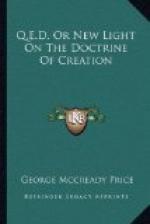No one of to-day, in the light of the correlation of vital processes with the general law of the conservation of energy, believes that life in plants and animals is a separate entity which may exist outside of and apart from matter. In a scientific sense, we only know life by its association with living matter, which in its simplest form is known as protoplasm. The latter has been termed the physical basis of life, and so far as we know every material living thing is composed wholly of protoplasm and of the structures which it has built up.
This grayish, viscid, slimy, semi-transparent, semi-fluid substance, similar to the white of an egg, is the most puzzling, the most wonderful material with which science has to deal. Chemically it is composed of various proteids, fats, carbohydrates, etc., and these in turn of but very few elements, all of which are common, and none of which are peculiar to protoplasm itself. And yet its essential properties, its mechanical as well as its chemical make-up, have baffled the resources of our wisest men with all their retorts and microscopes and other instruments of precision.
Protoplasm is essentially uniform and similar in appearance and properties wherever found, whether in the tissues of the human body, in a blade of grass, or in the green slime of a stagnant pool. And yet probably no two samples of protoplasm are ever exactly similar in all respects, though we may never be able to detect their precise differences. These differences are due to the fact that the stuff is alive, and within it are constantly going on those changes accompanying metabolism, or the building up and tearing down processes that always accompany life. All separate masses of protoplasm, such as the one-celled amoeba or the individual cells of our own bodies, are constantly taking in food and as constantly throwing off wastes. Hence, in the very nature of things, it is impossible to find any mass of protoplasm absolutely pure. And a further and impassable barrier to chemical analysis, or indeed to any adequate scientific examination, lies in the fact that we can never deal with protoplasm exactly as it is, since no analysis can be performed upon it without destroying its life. And yet even dead protoplasm, and especially its most characteristic constituent, proteid, has been found the most difficult material in the world to analyze, and nobody as yet pretends to know its exact chemical make-up.
The constant effort of natural science to press back the boundaries of the unknown is very liable to obscure some of the things most essential to any system of clear thinking regarding these matters. We are so prone to think that if only our microscopes were a little stronger, if only we could devise more effective methods of staining or of chemical analysis or chemical synthesis, we might really find out what life is, or what matter itself is; in short, that we might be




